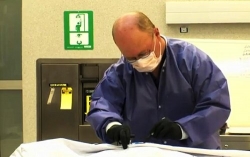
July 30, 2013 (San Diego) --For the second year in a row, deaths due to suicide and prescription drug overdoses were at record highs in San Diego County in 2012, and the number of homicides rose for the second year in a row.
The trends are detailed in the San Diego County Medical Examiner’s 2012 Annual Report released last week.
“Our office investigates every non-natural death in San Diego, and, tragically, many of these deaths are preventable,” Chief Deputy Medical Examiner Dr. Jonathan Lucas said. “The report reveals some of the serious issues and behaviors affecting San Diego County residents and visitors.”
In 2012, 10,018 deaths, or about half of the approximately 20,000 total deaths in the County, were reported to the San Diego County Medical Examiner. The office actively investigated 2,853 of those deaths and performed 1,962 autopsies and 901 external examinations.
The Medical Examiner’s Office investigates about five percent of the natural deaths in San Diego County. The office investigates every death due to non-natural causes, such as homicide, accident and suicide.
In 2012, 44 percent of the deaths investigated by the Medical Examiner were accidents, 36 percent were natural deaths, 15 percent were suicides and 4.6 percent were homicides. In one percent of cases, no manner of death could be determined.
Other findings among last year’s cases include:
- The County recorded a record number of suicides (413) and a suicide rate (13.1 per 100,000 people) that rose for the sixth year in a row. However, the rate is not a record—the highest suicide rate since 1988 was 14.5 in 1993. Rates were between 14.5 and 13.3 from 1990 through 1997. (For a complete table of suicide rates, see page 69 of the Annual report)
- 269 deaths were related to prescription drugs, a record number, an increase compared to 267 last year, and part of a disturbing trend seen over the last seven years.
- Heroin deaths have maintained the increase in frequency seen after 2007 and was the most common drug or medication in those from 20 to 29 who died of accidental overdose.
- Excluding alcohol, methamphetamine, still the number-one cause of drug/medication-related deaths for the population as a whole, continued its four-year increase, with meth linked to 142 deaths in 2012. Meth was the most common substance in those between 40 and 69 years old who died from accidental overdose.
- With 122 homicides, 2012 represented the second year in a row homicides rose after reaching a 20-year low in 2010. 2011 saw 91 homicides.
- 270 people died in a motor-vehicle related death. These cases include pedestrians, bicyclists, motorcyclists and people in cars. That was an increase over 2011, when 242 people died in motor-vehicle related deaths. But these deaths are still occurring at about half the rate of the early 90s, and 2010, 2011 and 2012 each saw fewer motor-vehicle related deaths and lower rates compared to any other year in the Medical Examiner’s records since 1988.
- Of drivers killed in car accidents, 43 percent were over the legal limit for blood alcohol content.
- Of 130 people who died in motor vehicle accidents, 42 were not wearing seatbelts and 67 were. Seat belt use could not be determined in 20 of the cases, and one death involved a golf cart.
- The leading cause of natural death among Medical Examiner cases remained cardiovascular disease.
As noted, many of the deaths the Medical Examiner’s Office investigates are preventable. The following resources may help:
- Mental health and substance abuse help is available to anyone who is struggling or worried about a friend or loved one. Counselors are always available at the County’s Behavioral Health Access and Crisis Line at 888-724-7240. Suicide prevention and awareness information is available at up2sd.org.
- 211 San Diego offers referrals to a wealth of family and individual services and programs. Call 2-1-1 or visit online
- Crime prevention resources from the Sheriff’s Department
- A list of prescription drug drop boxes












Recent comments